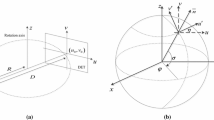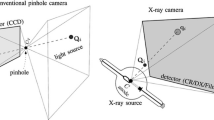Abstract
Calibration of an X-ray imaging system involves estimation of the 3D geometrical configuration of the system components. Here, we propose a calibration method for stereo X-ray imaging systems, which capture two X-ray images at two orthogonal positions. The calibration parameters include the relation between image coordinates and world coordinates, the relative 3D positions of the X-ray source and detector, and the rotational axis of the stereo X-ray system. The average error of the proposed calibration method was determined to be approximately 0.03% in evaluation tests.
Similar content being viewed by others
Abbreviations
- Π f :
-
front plane near the X-ray source of the two calibration planes of the calibration cube
- Π b :
-
back plane in contact with the detector of the two calibration planes of the calibration cube
- cp f,i (cp b,i ):
-
calibration points on Π f (Π b ) (i=1,...,n)
- cp′ f,i :
-
cp f,i ’s projected points on the detector
- l i :
-
projecting lines passing both cp f,i and cp′ f,i
- State 1 :
-
State of stereo X-ray system before rotating 90°
- State 2 :
-
State of stereo X-ray system after rotating 90°
- I 1 (I 2 ):
-
X-ray image at State 1 (State 2)
- CF :
-
calibration frame
- fp i :
-
calibration points of CF (i=1,...,n)
- fp 1,i :
-
image coordinates of fp i in actual radiograph I 1
- fp′ 1,i :
-
image coordinates computed by projecting fp i onto the detector at any assumed position of CF
- Ω:
-
rotating axis of stereo X-ray system
- Ω* dir (Ω* pivot ):
-
direction vector (pivot point) of estimated Ω
- t f * (r f *):
-
estimated translations (rotations) of CF
- I′ 2 :
-
X-ray image obtained from hypothesized X-ray system
- fp′ 2,i :
-
image coordinates calculated after projecting fp i in I′ 2
- fp 2,i :
-
image coordinates of fp i in actual radiograph I 2
- X n,src :
-
X-ray source position at State n (n=1,2)
- D n,cen :
-
center of detector at State n (n=1,2)
- D n,up :
-
upvector of detector at State n (n=1,2)
References
Stock, S. R., “Micro Computed Tomography: Methodology and Applications,” CRC Press, 2008.
Huang, R., Ma, K. L., McCormick, P., and Ward, W., “Visualizing industrial CT volume data for non-destructive testing applications,” Proc. of the IEEE Visualization, pp. 547–554, 2003.
Kim, Y. J., Kim, W. T., Choi, J. H., Son, T. G., Lee, S. B., and Lee, K. W., “Volume data inspection tools for industrial computed tomography,” WORLDCOMP’09, 2009.
Weiss, P., Le Nihouannen, D., Rau, C., Pilet, P., Aguado, E., Gauthier, O., Jean, A., and Daculsi, G., “Synchrotron and non synchrotron X-ray microtomography three-dimensional representation of bone ingrowth in calcium phosphate biomaterials,” European Cells and Materials, Vol. 9,Suppl. 1, pp. 48–49, 2005.
Kim, Y. J., Kim, K. I., Choi, J. H., and Lee, K. W., “Novel methods for 3D postoperative analysis of total knee arthroplasty using 2D–3D image registration,” Clinical Biomechanics, Vol. 26, No. 4, pp. 384–391, 2011.
You, B. M., Siy, P., Anderst, W., and Tashman, S., “In vivo measurement of 3-D skeletal kinematics from sequences of biplane radiographs: application to knee kinematics,” IEEE Trans. Med. Imaging, Vol. 20, No. 6, pp. 514–525, 2001.
Myung, D. K., Kim, Y. J., Choi, J. H., and Lee, K. W., “Scaled Attenuation Fields: Improved Real-time Generation Method for Digitally Reconstructed Radiographs,” Int. J. Precis. Eng. Manuf., Vol. 11, No. 5, pp. 791–798, 2010.
Russakoff, D. B., Rohlfing, T., Mori, K., Rueckert, D., Ho, A., Adler, J. R., and Maurer, C. R., “Fast generation of digitally reconstructed radiographs using attenuation fields with application to 2D–3D image registration,” IEEE Trans. Med. Imaging, Vol. 24, No. 11, pp. 1441–1454, 2005.
Bollet, M. A., McNair, H. A., Hansen, V. N., Norman, A., O’Doherty, U., Taylor, H., Rose, M., Mukherjee, R., and Huddart, R., “Can digitally reconstructed radiographs (DRRs) replace simulation films in prostate cancer conformal radiotherapy?” International Journal of Radiation Oncology, Biology, Physics, Vol. 57, No. 4, pp. 1122–1130, 2003.
Valstar, E. R., Nelissen, R. G. H. H., Reiber, J. H. C., and Rozing, P. M., “The use of Roentgen stereophotogrammetry to study micromotion of orthopaedic implants,” ISPRS Journal of Photogrammetry & Remote Sensing, Vol. 56, No. 5–6, pp. 376–389, 2002.
Press, W. H., Teukolsky, S. A., Vetterling, W. T., and Flannery, B. P., “Numerical Recipes in C++: The Art of Scientific Computing, 2nd ed.,” Cambridge University Press, pp. 417–424, 2001.
Author information
Authors and Affiliations
Corresponding author
Rights and permissions
About this article
Cite this article
Kim, Y., Kim, W., Park, S. et al. Calibration method for microscale stereo X-ray imaging system. Int. J. Precis. Eng. Manuf. 13, 877–882 (2012). https://doi.org/10.1007/s12541-012-0114-3
Received:
Accepted:
Published:
Issue Date:
DOI: https://doi.org/10.1007/s12541-012-0114-3




